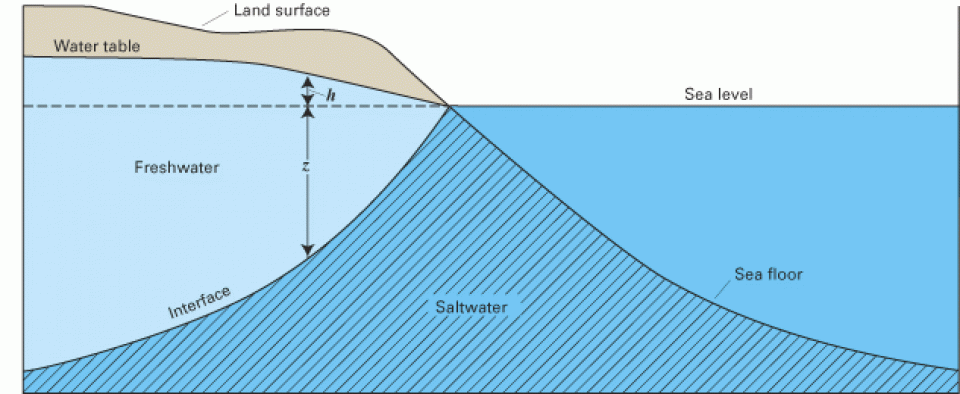Seawater Intrusion
Seawater intrusion can harm groundwater quality in a variety of places, both coastal and inland, throughout California.
Along the coast, seawater intrusion into aquifers is connected to overdrafting of groundwater. Additionally, in the interior, groundwater pumping can draw up salty water from ancient seawater isolated in subsurface sediments.
As pumps draw up freshwater from the aquifer, seawater flows inland into the aquifer by the force of the ocean. The flow of salty water can in turn create water quality problems.
Seawater Intrusion Overview
Along the coast, seawater intrusion began to occur in the 1920s in Ventura, Los Angeles and Orange counties in Southern California, where well water was the only available supply for many communities.
Since the 1920s, water managers in those areas have taken steps to push the salty water back toward the Pacific, and to restore and expand the ability of coastal aquifers to meet water needs.
In the 1950s and 1960s, for instance, water managers in Southern California began recharging the groundwater with water imported from the Colorado River and Northern California. The recharge water creates a hydraulic barrier between the fresh water aquifer and the intruding seawater. As water demands increased, managers in Orange County took the next step of using highly treated recycled water to maintain the barrier.
And in Los Angeles County, the West and Central Basin water districts oversee a series of seawater intrusion recharge wells that provide a hydraulic barrier of fresh water along the coast. The barrier water, which undergoes an extensive treatment process, meets or exceeds California and U.S. Environmental Protection Agency standards for drinking water.
Meanwhile, in the 1990s, the Orange County Water District and the Orange County Sanitation District joined efforts to ensure water reliability by developing a water purification program. The program takes highly treated wastewater that would have previously been discharged into the Pacific Ocean and purifies it to near-distilled-quality water.
The Salinas and Pajaro river valleys of Central California’s coast have also struggled with a serious seawater intrusion problem.
Fifty years of overdraft in the Salinas Valley have allowed the seawater to move five miles inland contaminating coastal groundwater aquifers and threatening the water supply for a $4 billion agricultural economy and the public water source for communities around Salinas.
Decades ago, Nacimiento and San Antonio reservoirs were constructed high in the Salinas River watershed to capture runoff, release it slowly and encourage groundwater recharge throughout the Salinas Valley. But irrigated agriculture in the upper valley increased, and recharge to the confined aquifers near the coast was too slow to be effective. To address the problem, the Monterey County Water Resources Agency began delivering recycled water to agricultural water users near the coast in 1998. And in 2010, the Salinas Valley Water Project completed an inflatable rubber dam near Salinas to capture more water while allowing fish to pass during wet periods.
Additionally, the northern San Joaquin Valley near Stockton has problems with pockets of seawater that pumps have drawn into the fresh water aquifers. In the northern Sacramento Valley, some pumpers are at risk of tapping into ancient deposits of seawater, which can degrade the quality of the groundwater.
And in one case, overpumping resulted in land subsidence and seawater intrusion – only the seawater was not about to invade the aquifer, but the city streets in Santa Clara County.
Santa Clara County grew by tapping the groundwater under the valley south of San Francisco Bay for agricultural irrigation, domestic and municipal supply. By the 1930s, the ground underneath the city of San Jose began to sink – raising the possibility that tidal water could inundate the community.
Since then, through the conjunctive management of surface water and groundwater, subsidence in the area has largely been halted at 13 feet. The district can adjust the water rates for surface water and groundwater to ensure the groundwater basin is protected from overdraft.
Seawater Intrusion Going Forward
A chief concern for the future is sea level rise as a result of climate change.
The California Department of Water Resources estimates that the sea levels near San Francisco rose by more than 0.6 feet in the 20th century. Based on 12 future climate scenarios, as air temperatures increase in the future, projections for global sea level rise are 0.4 feet to 1.2 feet at mid-21st century and 1.4 feet to 3.9 feet by the end of the century. Consequently, rising sea levels will bring more saline ocean water into the Sacramento-San Joaquin Delta. Additional fresh water will need to be released from upstream reservoirs to maintain water quality.
A sea level rise of only a few feet would inundate hundreds of square miles of land. San Francisco Bay and San Pablo Bay would enlarge, covering industry, residences and infrastructure. More surprising would be the enormous area of flooding that would occur in the Sacramento Valley. Hundreds of square miles would be underwater there and the intrusion of this salt water would have major environmental impacts.









